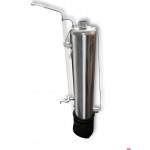
Critical Mistakes When Choosing a Household Autoclave
Let’s examine the main mistakes in the production of household autoclaves and what you should pay attention to as a buyer when choosing a manufacturer.
1. Flat Bottom or Top. Pressure does not get along with flat surfaces. An autoclave with such a design will not withstand the pressure and will inevitably bulge. No matter how much you are assured otherwise, it is important to know that in all pressure vessels, the top and bottom must be elliptical. Only this shape allows for easy handling of any loads without deforming.
Indeed, manufacturing an elliptical bottom is one of the most costly stages in the production of an autoclave, requiring special expensive equipment. It is much simpler to cut a circle from a sheet of metal with an angle grinder and weld it to the body, which some craftsmen do. Be sure to pay attention to this when choosing your autoclave!
2. Stainless Steel. We have all heard or maybe even experienced how low-quality stainless steel products behave. They burn out quickly, rust, and rot. It turns out it’s not truly stainless steel. This is very important, so when choosing an autoclave manufacturer, do not forget to ask about the grade of stainless steel used. Also, it is important to know the country of origin of the steel and you have the right to demand a certificate of quality for the metal. Stainless steel is not a cheap material, and working with it is highly valued. If you find a household autoclave made of stainless steel cheaper than a similar one from our production, you should pay attention to the quality of the steel it is made from. The manufacturer likely cut costs somewhere, and it's important to find out where.
3. Welding Stainless Steel. The most suitable, reliable, and convenient method for welding stainless steel is argon welding with a stainless filler. However, this method is also the most costly in terms of finances, and there are very few specialists who work with argon welding. We have often encountered stainless steel products that were welded using budget methods.
Another point is the weld itself. The metal should be welded from both sides; the weld cannot be superficial. Moreover, many customers ask why we do not remove the weld after welding. Indeed, today it is not a problem to grind and polish the weld to a perfect shine, so you would never guess where the tank was welded. However, this is prohibited because the vessel operates under pressure, and the weld must remain untouched. In fact, the weld and the quality of the applied seam can withstand greater loads and are the most reliable parts of the structure.
4. Autoclave Components. There are also issues here. To save costs, other manufacturers often install cheap Chinese safety valves or pressure gauges. This results in suffering for the buyer. A faulty pressure gauge can easily ruin the entire canning process, leaving you without your preserves. The most common defect in safety valves is that they activate not at 6 atm as they should, but at 3 atm, which also leads to loss of products. We won’t even discuss the safety issues. Our company directly uses components from the well-known and tested manufacturer AquaWorld.
5. Handmade Production. It is important to know who the manufacturer of your product is, where the production is located, and how many years they have been in the field. Additionally, you should receive a passport, product instructions, and a warranty card.
In this article, we have described the main problems that a buyer may face. Follow these recommendations, and your purchase will be successful!
You can order a high-quality autoclave made of stainless steel or black metal from our website. We offer a huge selection of models, quality assurance, and durability.
Also read:
- Autoclave Operating Modes
- What is an Autoclave
- Hydraulic Testing of Autoclaves
- How to Use an Autoclave
- How to Choose an Autoclave









